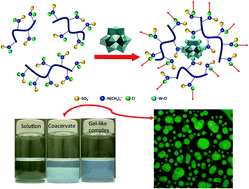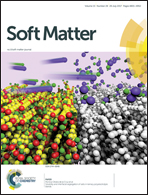Organic–inorganic macroion coacervate complexation†
Abstract
Coacervate complexes that are liquid–liquid separated complex materials are often formed by stoichiometrically mixing oppositely charged polyelectrolytes in salted aqueous solution. Entropy-driven ion pairing, resulting from the release of counterions near polyelectrolytes, has been identified as the primary driving force for coacervate formation between oppositely charged polyelectrolytes, including proteins and DNA, in aqueous solution. In this work we have examined the complexation between net neutral zwitterionic poly(sulfobetaine methacrylate) (PSBMA) and inorganic polyoxometalate (POM) polyanions in LiCl aqueous solutions. Biphasic liquid-like coacervate complexes can be formed over a much broader range of POM-to-PSBMA molar ratio and LiCl concentration than that for conventional polyelectrolyte coacervate complexation. Composition analysis of the dried supernatant and dense coacervate has confirmed that both PSBMA and POM macroions are primarily present in the dense coacervate as the macroion-rich phase in contrast to the presence of LiCl solely in the supernatant as the macroion-poor phase. The increase of net charge negativity of PSBMA and supernatant conductivity suggests stronger binding of PSBMA with POM anions than monovalent Cl−, resulting in the release of bound Cl− anions to the aqueous solution for the formation of PSBMA–POM coacervates in LiCl solution. All experimental evidence has demonstrated the generality of ion-pairing induced coacervate complexation with net neutral zwitterionic polymers and multivalent inorganic nanomaterials. The complexation between organic and inorganic macroions could give insights into many supramolecular assembly processes in nature and also lead to a new paradigm in developing hybrid macroionic materials for emerging applications from green catalysis to nanomedicine.



 Please wait while we load your content...
Please wait while we load your content...